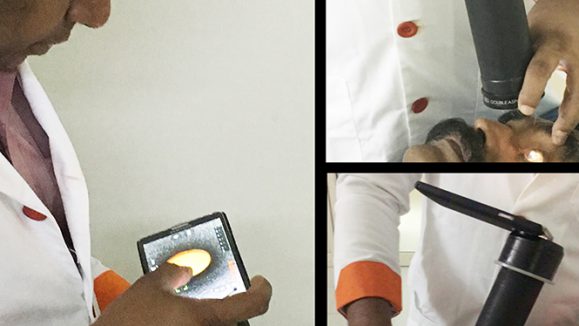On the morning of March 7th, 2024 history was made as a patient was wheeled into the OR at Ghent University Hospital, a complex of glass and concrete a ten-minute walk from the heart of the medieval Belgian city. The patient, a male of approximately 70 years of age, was suffering visual distortions caused by macular pucker.
Dr. Fanny Nerinckx, head of the hospital’s vitreoretinal unit, would be operating. But she wouldn’t be doing it alone.
This seemingly textbook procedure has now made history as the world’s first-ever robotically-assisted bi-manual, clinical-stage retinal surgery. And it was all down to the newcomer on her team—Luca™—a two-armed surgical robot ushering in a new era of high-tech ophthalmic surgery.
Doctor Roboto
Created by French medical robotics firm AcuSurgical (Montpellier, France), Luca was purpose-built for retinal surgery. At only 500μm thick, the retina is easily damaged and impossible to treat manually by all but the steadiest human hands, which have a non-negotiable minimum tremor of about 200μm.
Aided by robots like Luca, however, surgeons are able to transcend the physical limits of human dexterity. During surgery, the robot analyzes the forces imparted on the controls by its operator and scrubs out the vibrational noise.
Compensating for hand tremor—even the subtle vibrations arising from the surgeon’s heartbeat—Luca increases surgical precision to as fine as 10μm for a far more forgiving operational space. AcuSurgical has stated in press releases accompanying the surgery that its robot augments surgical precision by a factor of 20.
Dr. Hudson Nakamura, a Brazilian retinal surgeon and founder of Retinawesome, sees this as a critical aid for humans. The retina requires such delicate manipulation that, unaided, even the steadiest human hands are too jittery for anything more than the most rudimentary procedures.
“Imagine a doctor that did not sleep well or, though not advisable, who drinks.” He joked—though it is a prelude to a more serious—and crucial—point.
Hand tremor can be affected by any number of seemingly innocuous sources—from the caffeine in a cup of green tea to the sugar in a glazed doughnut to eating nothing at all.
Unlike the human nervous system, surgical robots are immune to such adverse influences. More importantly, their force sensitivity is not an immutable fact of biology, but a modifiable characteristic that can be heightened to an ultimately superhuman degree through engineering and software improvements.
Asked how working with Luca compared with manual surgeries, Dr. Nerinckx echoed the promise of this precision in comments to this publication. “The most significant difference was the insertion of the instruments through the trocars with the robot. Once in the eye, the procedure is very similar to conventional manual surgery but with enhanced movement control.”
No assistance required?
It is this capability that has long tantalized legions of eye care practitioners. But following the success of Dr. Nerinckx’ surgery with Luca, some specialists are already dreaming of more.
Dr. Nakamura sees today’s routine anterior surgeries as fertile ground for the eventual deployment of the next level of robotic wizardry. In his eyes, Luca’s mighty achievement is impressive not only for the capabilities coming in the near future, but also the far future.
The next evolution in surgical robots are integrated platforms capable of executing entire multi-phase surgeries, and Dr. Nakamura believes that thanks to machine learning, the deployment of such an innovation is eminently realistic.
“We have all the apparatus we need to do surgery in terms of visualization and imaging; machines for cutting the vitreous, retractors, illumination—we have technology for doing surgeries in the best way possible with the best machines,” he said.
According to Dr. Nakamura, however, roadblocks remain in one key area on the road to this seemingly science fiction future. “We do not have integration systems, like small platforms that could be placed on top of the eye to regulate depth. We’ve got the tools but we don’t really have the interface.”
The not-so-distant future
Though such functionality might be far off, Dr. Nerinckx sees great promise just around the corner in robots like Luca. At the present pace of innovation, it won’t be long before robotic manipulation systems allow surgeons to detect resistances below the threshold of even the most sensitive human hands. Thus equipped, VR surgeons would have access to microstructures an order of magnitude smaller than our present reach.
Asked what treatment pathways such precision might enable, Dr. Nerinckx offered intriguing predictions. “In the future we presume the robot will give us the possibility to perform new retinal surgeries like vascular cannulation (a retinal vein is about 120 microns in diameter),” she said.
“And also the robot could help the surgeon to work for a prolonged time in the subretinal space, for example, to more precisely deliver gene therapy, then stem cell therapy—eventually therapeutic nanoparticles.”
Speculating along similar lines, a recent study also foresees the potential for microcannulation as a means to treat occlusive diseases in the retinal vasculature or deliver chemotherapy compounds directly into the blood vessels supplying intraocular tumors.1
Of course such breakthroughs are for another day. Luca is still undergoing clinical trials, Dr. Nerinckx is quick to remind. Once such hurdles are cleared, however, she sees Luca helping ophthalmology address a more pressing concern—the difficulty of training VR surgeons.
“The robot will allow for the safer training of fellows, since the robot filters for tremor but also provides a counter resistance which helps to prevent damage to the retina. Overall, robotics is helping improve patients’ safety by standardizing surgery–a fact I believe will be demonstrated through further clinical studies.”
Editor’s Note: A previous version of this article contained inaccuracies about the extent of Luca’s automation capabilities and its classification as a level 3 surgical robot–we sincerely regret any inconvenience caused.
Reference
- Channa, R, Iordachita, Iulian, Handa, James T. Robotic Vitreoretinal Surgery. Retina. 2017; 37(7):1220-1228.





